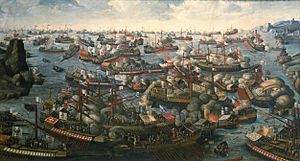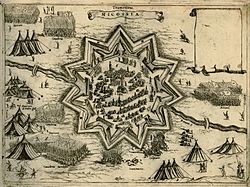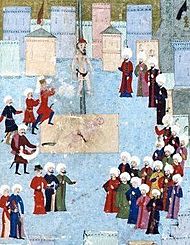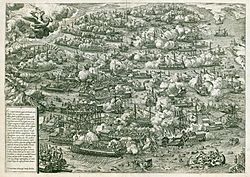Ottoman–Venetian War (1570–1573) facts for kids
Quick facts for kids Fourth Ottoman–Venetian War |
|||||||||
|---|---|---|---|---|---|---|---|---|---|
| Part of the Ottoman–Venetian Wars | |||||||||
 The Battle of Lepanto |
|||||||||
|
|||||||||
| Belligerents | |||||||||
|
|||||||||
| Commanders and leaders | |||||||||
The Fourth Ottoman–Venetian War, also known as the War of Cyprus, was a big conflict that happened between 1570 and 1573. It was fought between the Ottoman Empire and the Republic of Venice. Venice was joined by the Holy League, a group of Christian states put together by the Pope. This group included powerful states like Spain, the Republic of Genoa, and the Knights Hospitaller.
The war started when the Ottomans invaded the island of Cyprus, which Venice controlled. The capital city, Nicosia, and other towns quickly fell to the much larger Ottoman army. Only Famagusta remained in Venetian hands. Help for the Christians was slow to arrive. Famagusta finally fell in August 1571 after being under attack for 11 months. Two months later, at the Battle of Lepanto, the Christian fleet destroyed the Ottoman fleet. However, they couldn't use this victory to their full advantage. The Ottomans quickly rebuilt their navy. Venice had to make a separate peace deal, giving Cyprus to the Ottomans and paying a large sum of money.
Contents
Why the War Started
The island of Cyprus was large and wealthy. It had been under Venetian rule since 1489. Cyprus was very important to Venice, like Crete. It helped Venice control trade in the Levant (the eastern Mediterranean). The island also produced a lot of cotton and sugar. To protect Cyprus, Venice paid a yearly tribute to the Mamluk Sultans of Egypt. When the Ottomans conquered Egypt in 1517, Venice continued this payment to them.
However, Cyprus was in a very important spot. It was between the Ottoman homeland of Anatolia and their new lands in the Levant and Egypt. This made it a tempting target for the Ottomans. Also, Venetian officials in Cyprus sometimes protected pirates. These pirates attacked Ottoman ships, including those carrying Muslim pilgrims going to Mecca. This made the Ottoman leaders very angry.
After a long war in Hungary, the Ottomans were free to focus on Cyprus. Sultan Selim II wanted to conquer the island even before he became ruler in 1566. Some stories say he wanted Cyprus because he loved its wines. But a powerful Jewish advisor named Joseph Nasi also pushed for the war. He hoped to become the King of Cyprus after the Ottomans took it.
Even though Venice and the Ottomans had a peace treaty, the war party in the Ottoman court won. They got a religious opinion that said the treaty could be broken. This was because Cyprus had briefly been a "land of Islam" in the 7th century. Money for the war was raised by taking over and selling churches and monasteries. Lala Mustafa Pasha was put in charge of the land forces. Müezzinzade Ali Pasha led the navy, with the experienced Piyale Pasha helping him.
On the Venetian side, they knew an attack on Cyprus was coming. They had been worried since 1564. The Ottomans had visited Cyprus in 1568, pretending it was a friendly visit. But they were really spying on the island's defenses. Venice tried to improve its defenses on Cyprus and other islands. They built foundries and gunpowder mills. However, everyone knew Cyprus was far from Venice and surrounded by Ottoman lands. It was "in the wolf's mouth," as one historian said. Lack of supplies and gunpowder later played a big part in the fall of Venetian forts. Venice also couldn't get much help from Habsburg Spain. Spain was busy fighting a revolt in the Netherlands.
By early 1570, Venice was sure war was about to begin. They sent more soldiers and money to Cyprus. In March 1570, the Ottomans sent a message to Venice. They demanded that Venice give up Cyprus immediately. Some Venetian leaders thought about giving up the island for other benefits. But the hope of help from other Christian states made Venice refuse the demand.
Ottoman Takeover of Cyprus
On June 27, the Ottoman invasion force set sail for Cyprus. It had about 350-400 ships and 60,000-100,000 soldiers. They landed easily near Larnaca on July 3. Then they marched towards the capital, Nicosia. The Venetians decided not to fight them on the beaches. Instead, they pulled back to their forts to wait for help.
The siege of Nicosia started on July 22 and lasted seven weeks. The city's new walls, built in a style called trace italienne (Italian trace), held up well against the Ottoman cannons. The Ottomans, led by Lala Mustafa Pasha, dug trenches towards the walls. They slowly filled the surrounding ditch. After 45 days, on September 9, they finally broke through the walls. The defenders had run out of ammunition. After the city fell, many people were killed or captured. A Christian fleet of 200 ships had gathered in Crete. But when they heard Nicosia had fallen, they turned back.
After Nicosia fell, the fortress of Kyrenia surrendered without a fight. On September 15, the Ottoman cavalry reached Famagusta, the last Venetian stronghold. The Venetian defenders in Famagusta had about 8,500 men and 90 cannons. They were led by Marco Antonio Bragadin. They held out for 11 months against a huge Ottoman force of 200,000 men and 145 cannons. This gave the Pope time to form an alliance against the Ottomans.
The Ottomans started firing their cannons on September 1. Over the next months, they dug a huge network of trenches around the fortress. This gave their troops shelter. As the trenches got closer, they built ten forts of wood and earth. However, the Ottomans couldn't completely block the city from the sea. The Venetians were able to send supplies and more soldiers. The Ottoman leader Lala Mustafa Pasha was left alone in charge of the siege. The Ottomans offered Venice a trading post in Famagusta if they gave up the island. But Venice refused, hoping for help from the Christian alliance. On May 12, 1571, the heavy bombing of Famagusta began. On August 1, with no ammunition or supplies left, the city surrendered. The siege of Famagusta was very costly for the Ottomans, with many casualties.
The Holy League Forms
While the Ottoman army was fighting in Cyprus, Venice tried to find allies. The Holy Roman Emperor had just made peace with the Ottomans and didn't want to break it. France was usually friendly with the Ottomans and against Spain. Spain, the strongest Christian power in the Mediterranean, wasn't eager to help Venice at first. They were busy fighting revolts in the Netherlands and against the Moriscos (Muslims who had converted to Christianity) at home. Spain also remembered that Venice hadn't helped them during the siege of Malta in 1565.
However, with strong efforts from Pope Pius V, an alliance against the Ottomans was formed. It was called the "Holy League" and was agreed upon on May 15, 1571. The agreement said they would gather a fleet of 200 galleys (large ships), 100 supply ships, and 50,000 men. To get Spain to agree, Venice also promised to help Spain in North Africa.
In late summer, the Christian fleet gathered at Messina. It was led by Don John of Austria, who arrived on August 23. By this time, Famagusta had already fallen. So, saving Cyprus was no longer possible. Before sailing east, Don John had to deal with the distrust between the different groups, especially between the Venetians and the Genoese. He solved this by mixing ships from different states together. The allied fleet left Messina on September 16. Ten days later, they reached Corfu. There, they learned about the Ottoman victory in Cyprus. The Ottoman fleet, led by Müezzinzade Ali Pasha, was anchored at Lepanto (Nafpaktos).
The Battle of Lepanto
Both sides wanted a decisive battle. They had gathered most of the galleys in the Mediterranean at that time. The fleets were quite balanced. The Ottoman fleet was larger with 278 ships compared to 212 Christian ships. But the Christian ships were stronger. Both fleets had about 30,000 soldiers. The Ottomans had more sailors and oarsmen. The Christians had twice as many cannons, but the Ottomans had many skilled archers.
On October 7, the two fleets fought the Battle of Lepanto. The Christian fleet won a huge victory. The Ottoman fleet was almost completely destroyed. They lost about 25,000-35,000 men. About 12,000 Christian galley slaves were freed. This battle became known as a major turning point. It ended the Ottoman control of the seas that had started in 1538. However, the immediate results were small. The cold winter stopped the Holy League from attacking further. The Ottomans used this time to quickly rebuild their navy.
The Ottoman Grand Vizier (a top minister) famously said to the Venetian ambassador: "The Christians have singed my beard [meaning the fleet], but I have lopped off an arm. My beard will grow back. The arm [meaning Cyprus], will not." Even with this bold statement, the Ottoman navy was badly hurt. They lost many experienced officers, sailors, and technicians. The Venetians and Spanish executed the captured experts. The Battle of Lepanto, along with the Ottoman failure at Malta six years earlier, confirmed that the Mediterranean was divided. The eastern part was controlled by the Ottomans, and the western part by Spain and its Italian allies.
The next year, the Christian fleet started operations again. They faced a new Ottoman navy of 200 ships. The Ottoman commander avoided fighting the allied fleet. He knew his new ships were built quickly and had inexperienced crews. The Christian leaders also had disagreements. This caused them to miss chances for a big victory.
The different goals of the Holy League members started to cause problems. The alliance began to fall apart. In 1573, the Holy League fleet didn't even sail together. Instead, Don John attacked and took Tunis. But the Ottomans took it back in 1574. Venice feared losing its lands in Dalmatia and a possible invasion of Friuli. They wanted to stop their losses and restart trade with the Ottoman Empire. So, Venice began talking directly with the Ottomans.
Peace and What Happened Next
Andrea Biagio Badoer, a special ambassador, handled the peace talks for Venice. Venice could not get Cyprus back. So, the treaty, signed on March 7, 1573, confirmed the new situation. Cyprus became an Ottoman province. Venice also had to pay a large sum of 300,000 ducats. The border between the two powers in Dalmatia also changed. The Ottomans took over small but important farming areas near Venetian cities. This hurt the economy of those cities.
Peace between Venice and the Ottomans lasted until 1645. Then, a long war over Crete broke out. Cyprus itself remained under Ottoman rule until 1878. At that time, it was given to Britain as a protectorate. Ottoman rule officially ended when World War I started. Britain then annexed the island, making it a crown colony in 1925.
Images for kids
See also
 In Spanish: Guerra turco-veneciana (1570-1573) para niños
In Spanish: Guerra turco-veneciana (1570-1573) para niños






